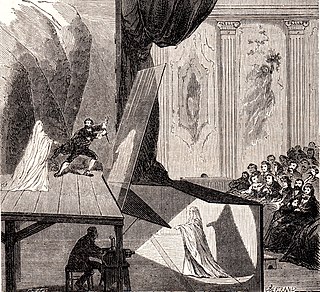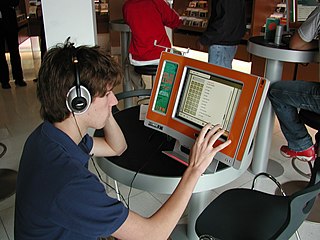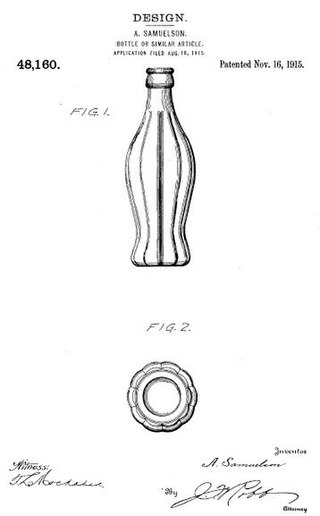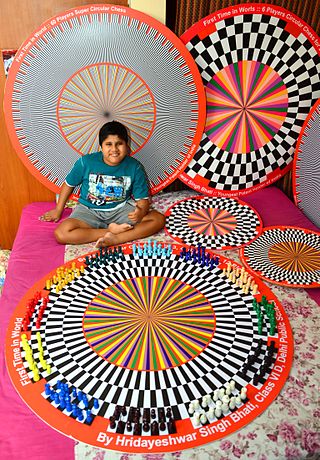Related Research Articles

Intellectual property (IP) is a category of property that includes intangible creations of the human intellect. There are many types of intellectual property, and some countries recognize more than others. The best-known types are patents, copyrights, trademarks, and trade secrets. The modern concept of intellectual property developed in England in the 17th and 18th centuries. The term "intellectual property" began to be used in the 19th century, though it was not until the late 20th century that intellectual property became commonplace in most of the world's legal systems.

A patent is a type of intellectual property that gives its owner the legal right to exclude others from making, using, or selling an invention for a limited period of time in exchange for publishing an enabling disclosure of the invention. In most countries, patent rights fall under private law and the patent holder must sue someone infringing the patent in order to enforce their rights.
A software patent is a patent on a piece of software, such as a computer program, libraries, user interface, or algorithm.
The state of the art refers to the highest level of general development, as of a device, technique, or scientific field achieved at a particular time. However, in some contexts it can also refer to a level of development reached at any particular time as a result of the common methodologies employed at the time.

A yo-yo is a toy consisting of an axle connected to two disks, and a string looped around the axle, similar to a spool. It is an ancient toy with proof of existence since 500 BC. The yo-yo was also called a bandalore in the 17th century.

In music, groove is the sense of an effect ("feel") of changing pattern in a propulsive rhythm or sense of "swing". In jazz, it can be felt as a quality of persistently repeated rhythmic units, created by the interaction of the music played by a band's rhythm section. Groove is a significant feature of popular music, and can be found in many genres, including salsa, rock, soul, funk, and fusion.

Pepper's ghost is an illusion technique, used in the theatre, cinema, amusement parks, museums, television, and concerts, in which an image of an object off-stage is projected so that it appears to be in front of the audience.

A choc ice or ice cream bar is a frozen dessert generally consisting of a rectangular block of ice cream—typically vanilla flavour—which is thinly coated with chocolate. Related products may also include other fillings with the ice cream and be styled similar to candy bars. The term has also been used as a racial slur.

A touchscreen or touch screen is the assembly of both an input and output (display) device. The touch panel is normally layered on the top of an electronic visual display of an electronic device.
Novelty is one of the patentability requirement for a patent claim, whose purpose is to prevent issuing patents on known things, i.e. to prevent public knowledge from being taken away from the public domain.
Novelty is the characteristic of being new or heretofore unseen. It may also refer to:

In the United States, a design patent is a form of legal protection granted to the ornamental design of an article of manufacture. Design patents are a type of industrial design right. Ornamental designs of jewelry, furniture, beverage containers and computer icons are examples of objects that are covered by design patents.

In Indian cinema, an item number or special song is a musical number inserted into a film that may or may not have any relevance to the plot. The term is commonly used within Indian films and to a lesser extent within Pakistani films to describe a catchy, upbeat, often provocative dance sequence for a song performed in a movie. The main aim of an item number is to entertain movie-goers and to lend support to the marketability of the film by being featured in trailers. They are favoured by filmmakers as they afford the opportunity to pick potential hit songs from the stocks, since they do not add to the continuity of the plot. It is thus a vehicle for commercial success that ensures repeat viewing.

A utility model is a patent-like intellectual property right to protect inventions. This type of right is available in many countries but, notably, not in the United States, United Kingdom or Canada. Although a utility model is similar to a patent, it is generally cheaper to obtain and maintain, has a shorter term, shorter grant lag, and less stringent patentability requirements. In some countries, it is only available for inventions in certain fields of technology and/or only for products. Utility models can be described as second-class patents.

In international law and business, patent trolling or patent hoarding is a categorical or pejorative term applied to a person or company that attempts to enforce patent rights against accused infringers far beyond the patent's actual value or contribution to the prior art, often through hardball legal tactics. Patent trolls often do not manufacture products or supply services based upon the patents in question. However, some entities, which do not practice their asserted patent, may not be considered "patent trolls", when they license their patented technologies on reasonable terms in advance.
Patents are legal instruments intended to encourage innovation by providing a limited monopoly to the inventor in return for the disclosure of the invention. The underlying assumption is that innovation is encouraged because an inventor can secure exclusive rights and, therefore, a higher probability of financial rewards for their product in the marketplace or the opportunity to profit from licensing the rights to others. The publication of the invention is mandatory to get a patent. Keeping the same invention as a trade secret rather than disclosing it in a patent publication, for some inventions, could prove valuable well beyond the limited time of any patent term but at the risk of unpermitted disclosure or congenial invention by a third party.

Kites are tethered flying objects which fly by using aerodynamic lift, requiring wind for generation of airflow over the lifting surfaces.

Kickstarter is an American public benefit corporation based in Brooklyn, New York, that maintains a global crowdfunding platform focused on creativity. The company's stated mission is to "help bring creative projects to life". As of February 2023, Kickstarter has received US$7 billion in pledges from 21.7 million backers to fund 233,626 projects, such as films, music, stage shows, comics, journalism, video games, board games, technology, publishing, and food-related projects.

The Leahy–Smith America Invents Act (AIA) is a United States federal statute that was passed by Congress and signed into law by President Barack Obama on September 16, 2011. The law represents the most significant legislative change to the U.S. patent system since the Patent Act of 1952 and closely resembles previously proposed legislation in the Senate in its previous session.

Hridayeshwar Singh Bhati was an Indian student who invented a six-player variant of chess at the age of 9 with assistance from his father. He earned a patent for his invention in 2012, making him the youngest patent-holder in India at that time. For his invention Bhati received the CavinKare Ability Special Recognition Award and the Sri Balaji Society's Child Innovator Award. He since designed and received patents for twelve- and sixty-player versions of his game, with his boards capable of 100 distinct variations altogether.
References
- ↑ "Novelty". Merriam-Webster.com. Retrieved January 27, 2012.
- ↑ Berlyne, D.E. (1960). Conflict, arousal, and curiosity. McGraw-Hill Book Company.
- ↑ "Tips On Choosing the Right Novelty for your Market". ThemeLib. April 9, 2011. Archived from the original on 2011-04-14. Retrieved January 22, 2012.
- ↑ Iryna Zenyuk (August 12, 2010). "Endgame Novelty". chess.com. Retrieved January 27, 2012.
- ↑ Mary Bellis. "Guide To Patenting And USPTO Patent Applications". About.com Inventors. Archived from the original on July 9, 2012. Retrieved January 22, 2012.
- ↑ "Spider-man renewed and the novelty effect". Thought Gadgets. Retrieved January 22, 2012.